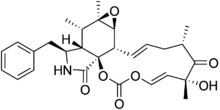Cytochalasin E
 | |
| Identifiers | |
|---|---|
3D model (JSmol) |
|
| ChemSpider | |
| ECHA InfoCard | 100.048.018 |
| EC Number | 252-835-7 |
PubChem CID |
|
| |
| |
| Properties | |
| C28H33NO7 | |
| Molar mass | 495.57 g·mol−1 |
| Density | 1.309 g/ml |
| Hazards | |
| Main hazards | Toxic |
EU classification (DSD) (outdated) |
T+ |
| R-phrases (outdated) | R26/27/28 R63 |
| S-phrases (outdated) | S28 S36/37 S45 |
Except where otherwise noted, data are given for materials in their standard state (at 25 °C [77 °F], 100 kPa). | |
| Infobox references | |
Cytochalasin E, a member of the cytochalasin group, is an inhibitor of actin polymerization in blood platelets. It inhibits angiogenesis and tumor growth. Unlike cytochalasin A and cytochalasin B, it does not inhibit glucose transport.
Because of its antiangiogenic effect, cytochalasin E is a potential drug for age-related macular degeneration, a kind of blindness caused by an abnormal proliferation of blood vessels in the eye.[2]
Cytochalasin E was found to be a potent and selective inhibitor of bovine capillary endothelial (BCE) cell proliferation. Cytochalasin E differs from other cytochalasin molecules by having an epoxide, which is required for specificity and potency. Cytochalasin E is a potent antiangiogenic agent that may be useful for treatments of cancer and other pathologic angiogenesis.[3]
References
- ↑ Cytochalasin E from Aspergillus clavatus at Sigma-Aldrich
- ↑ eyesight.org Archived 2006-05-19 at the Wayback Machine.
- ↑ Udagawa, T; Yuan, J; Panigrahy, D; Chang, YH; Shah, J; D'Amato, RJ (August 2000). "Cytochalasin E, an epoxide containing Aspergillus-derived fungal metabolite, inhibits angiogenesis and tumor growth". J. Pharmacol. Exp. Ther. 294: 421–7. PMID 10900214.
External pages
Cytochalasin E from Fermentek
Cytochalasin E from Cayman Chemical